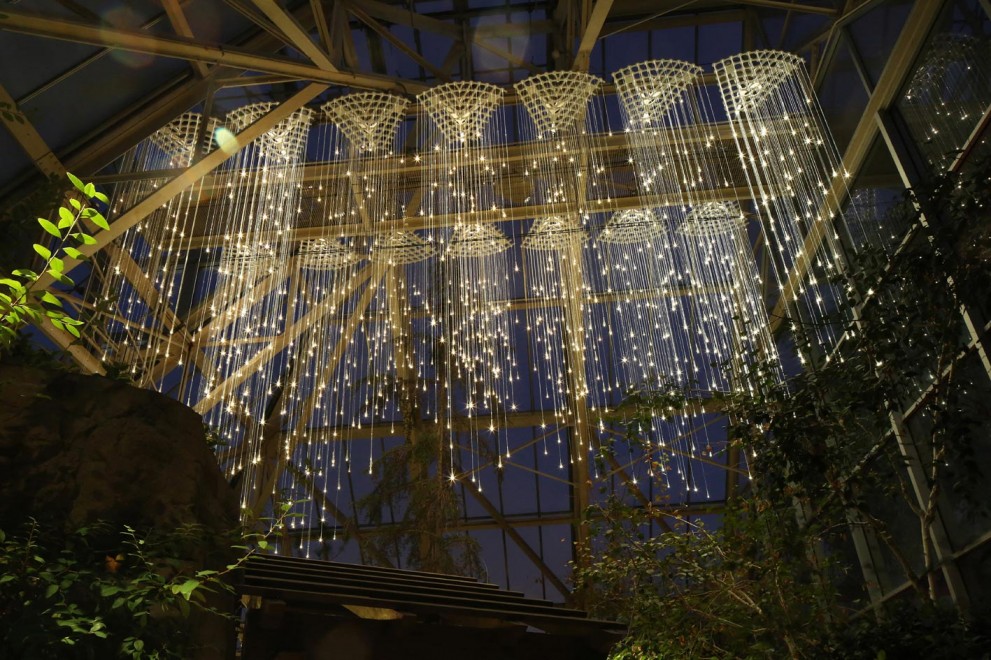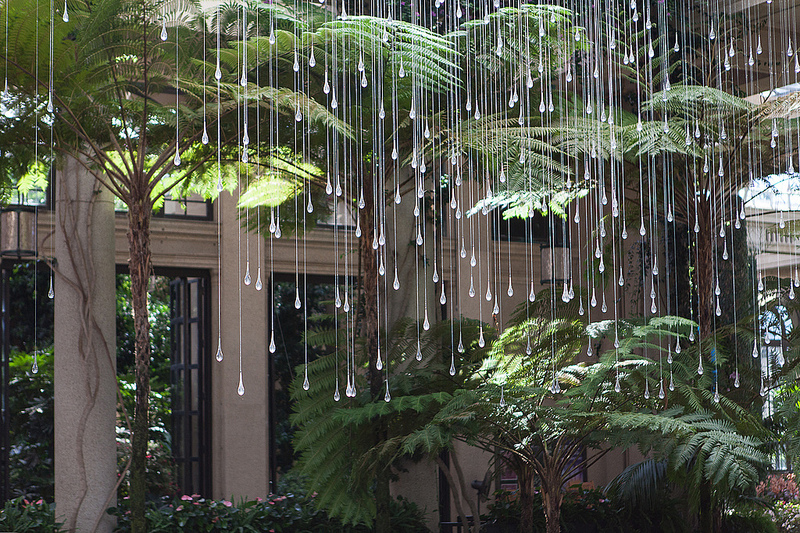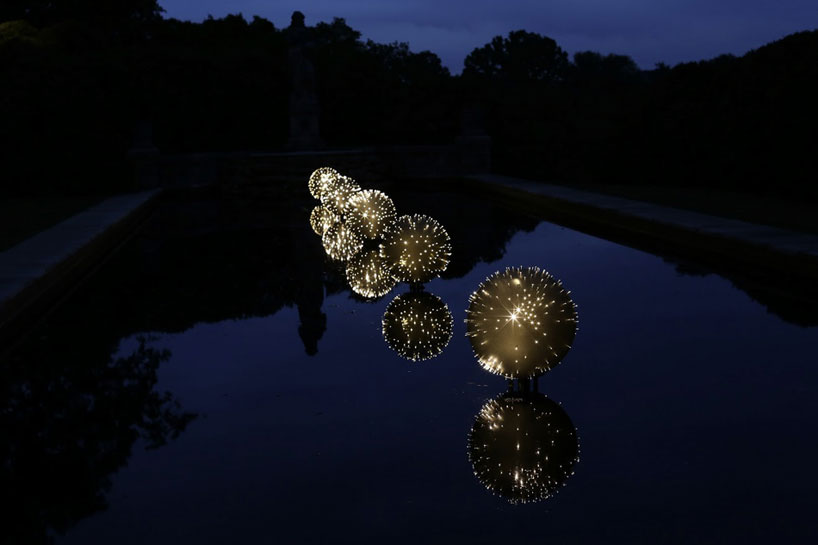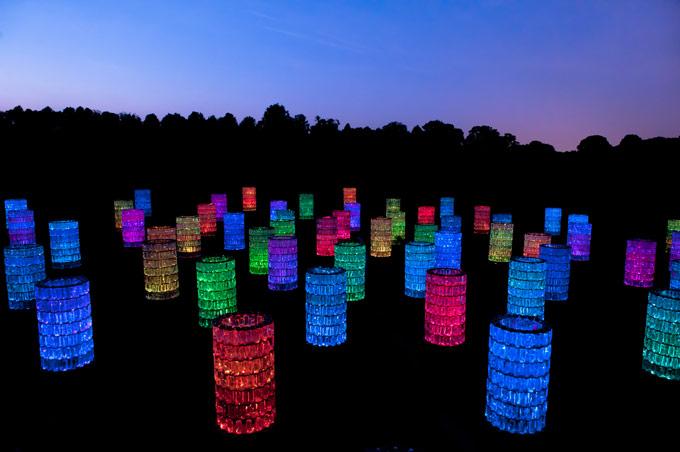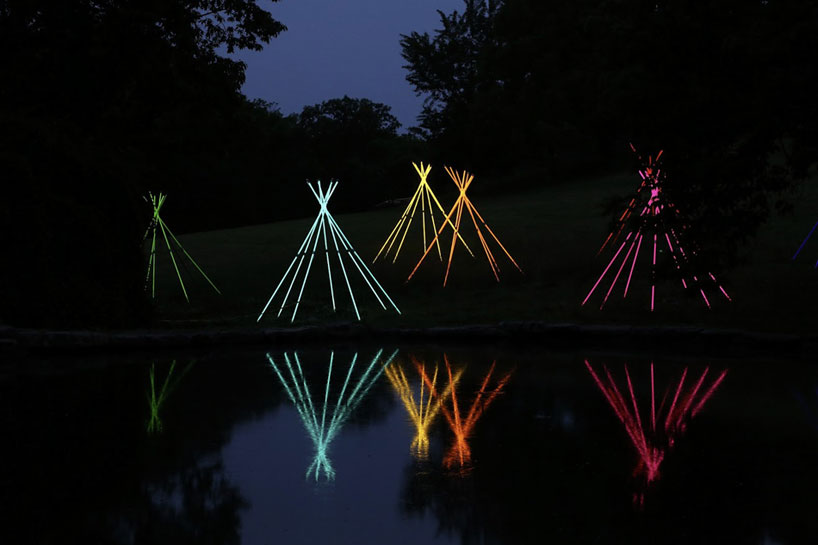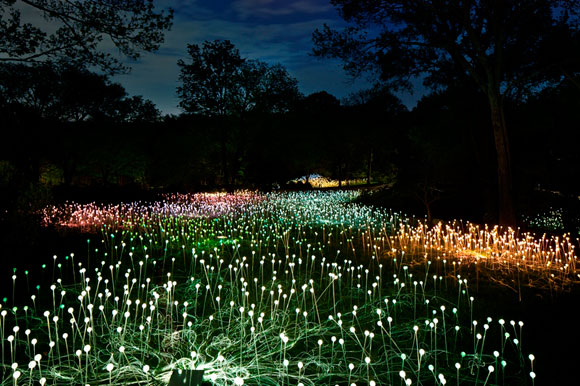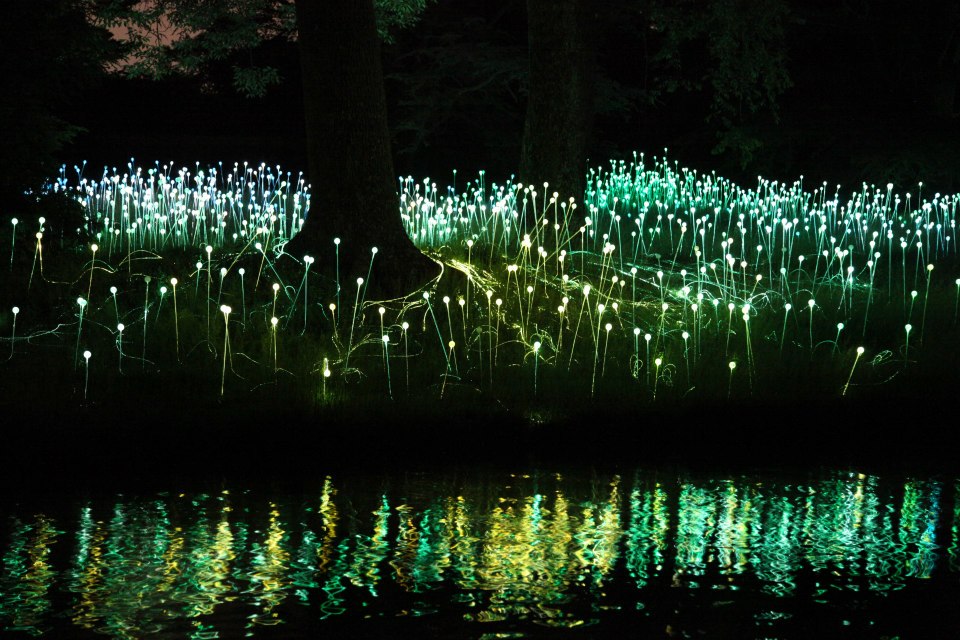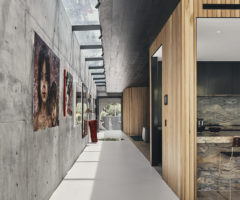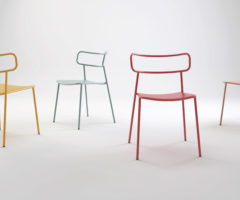Intitolare un post così può apparire impegnativo, eppure, osservando le opere di Bruce Munro, si ha proprio la sensazione di assistere ad un sogno di mezza estate. Artista britannico, Munro è conosciuto soprattutto per le sue grandi installazioni, in cui la luce gioca un ruolo fondamentale, e che sono ispirate dal suo interesse per le esperienze sensoriali dell’uomo. Un light designer raffinato che in trent’anni di attività ha saputo affrontare committenze di ogni genere con creatività e tecniche all’avanguardia. Tutte le sue riflessioni sulla musica, la letteratura, la scienza e, più in generale sulla vita, sono sempre state tradotte in opere poetiche e visionarie, in cui l’invenzione e l’esperienza viaggiano inseparabili. Molto attento all’ambiente, Munro utilizza prevalentemente fibre ottiche e led, miscelando sapientemente le due tecnologie e scegliendo materiali di recupero o ecocompatibili per creare le sue magiche scenografie. Bottiglie di plastica, vecchi cd, pezzetti di vetro, tutti oggetti di semplice uso quotidiano, che la sua poetica trasforma in opere vibranti e cariche di emozione.
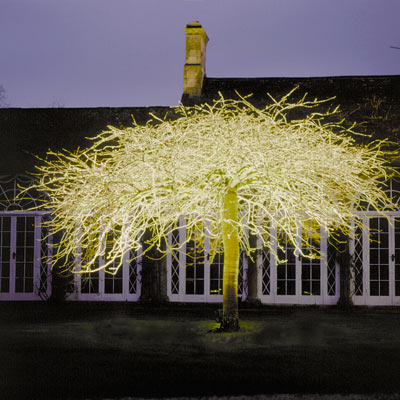
The title might seem at first a little exaggerated, but observing the works of Bruce Munro you really feel drawn into a midsummer night’s dream. The British artist is mostly known for his large-scale installations, in which light plays a major role, and which are inspired by his interest in the sensory experience of man. A refined light designer that in thirty years has worked with all kinds of creative commissions and cutting edge techniques. All his thoughts on music, literature, science and, more generally, about life, have always been translated into visionary poems. Very aware of the environment, Munro uses mainly fiber optics and LED, cleverly mixing the two technologies and choosing recycled or eco-friendly objects to create its magical scenery. Plastic bottles, old CDs, pieces of glass, all objects of everyday use, which his poetic work transformed into vibrancy and emotion.
Light Shower è il titolo dell’opera rappresentata dalle due immagini. Munro ebbe l’ispirazione durante un soggiorno di lavoro presso il lago di Loch in Scozia nel 2008. Un giorno, durante un forte acquazzone, si mise ad osservare lo scroscio della pioggia contro i vetri e subito rimase affascinato dal gioco di luci e riflessi che le gocce creavano. La prima installazione pubblica di Light Shower fu nel 2010 quando Munro venne incaricato di creare un elemento speciale all’interno della cattedrale di Salisbury.
Light Shower is the title of the piece in these two images. Munro was inspired during a business trip to Lochs in Scotland in 2008. One day, during a heavy downpour, he observed the sound of the rain against the windows and immediately became fascinated by the play of light and reflections the drops created. The first public installation of Light Shower was in 2010 when Munro was asked to create a special element inside the Salisbury Cathedral.
I Ricci di Fagin è un’opera appositamente creata per la piscina dei riflessi all’interno del Martin Boxwood Gardens a Cheekwood. Il nome, a detta dello stesso Munro, è ispirato alla lettura del romanzo Oliver Twist, in cui Fagin è la figura del ladruncolo malvagio e privo di scupoli.
The Ricci Fagin is a work specially created for the pool of reflections inside the Martin Boxwood Gardens at Cheekwood. The name, according to the same Munro, is inspired by the reading of the novel Oliver Twist, in which Fagin is an evil and ruthless thief .
All’età di 21 anni Bruce Munro lesse un testo importante per la sua formazione culturale; The Gifts of Unknown Things, scritto da Lyall Watson, uno scienziato radicale che operava ai margini della scienza ufficiale. Watson racconta nel libro la storia di una ragazza, Tia, che viveva su un’isola dell’arcipelago indonesiano, dotata di poteri particolari. Tia “vedeva” i suoni come se fossero colori. Watson chiamò il fenomeno Color Synesthesia. Egli inoltre sosteneva che la Terra avesse un cuore pulsante alla velocità di 69 battiti al giorno, la cui frequenza sonora non era udibile dall’orecchio umano. Affascinato da queste teorie Munro concepì nel 2010 L’opera Water Tower in cui, colore e suoni convivono armoniosamente. 69 Torri, ciascuna alta due metri e costruita con 200 bottiglie di plastica. Fibre ottiche consentono il cambiamento del colore della luce in sintonia con il mutare della musica.
At 21 Bruce Munro read The Gifts of Unknown Things, written by Lyall Watson, a radical scientist who operated on the margins of mainstream science. Watson tells in the story of a girl with special powers, Tia, who lived on an island in the Indonesian archipelago. Tia “saw” sounds as if they were colors. Watson called the phenomenon Color Synesthesia. He also alleged that the Earth had a heart beating at a speed of 69 beats per day, the frequency of sound not audible to human ear. Fascinated by these theories Munro conceived in 2010 The Water Tower, where color and sounds coexist harmoniously. 69 towers, each two meters high and built with 200 plastic bottles. Optical fibers allow the change of the color of light in tune with the changing music.
Tepee nasce quasi per caso. Da anni Munro cercava un modo sicuro per proteggere, dalle volpi, le galline della casa di campagna in cui Lui e sua moglie trascorrevano le vacanze. Un giorno un contadino gli suggerì di costruire delle gabbie aperte formate da tubi fluorescenti che emettevano campi magnetici. Anni dopo, Munro trovò la combinazione perfetta per i tubi fluorescenti colorati. Una forma a capanna indiana, molto cara al West americano. L’immagine fotografia non riesce a cogliere la bellezza di questa installazione, che prevede sequenze ritmate di cambio colore, sempre al suono della musica.
Tepee born almost by chance. For years Munro had been looking for a safe way to protect hens of the country house in which he and his wife spent their holidays from foxes. One day a farmer told him to build open cages formed by fluorescent tubes which create magnetic fields. Years later, Munro found the perfect combination of colored fluorescent tubes in the shape of an Native American hut, an image very dear to the American West. The photograph can not capture the beauty of this installation, which includes rhythmic sequences of color change, again to the sound of music.
Durante un viaggio in Australia, percorrendo il Deserto Rosso, Munro fu ispirato dall’energia sprigionata dal paesaggio. Così anni dopo nacque Field of Light in cui si riflette questo stupore per la vitalità della Terra.
Ecco cosa afferma a proposito di quest’opera: “Volevo creare un campo illuminato di steli che, come il seme dormiente in un deserto secco, sarebbe sbocciato in fiore al crepuscolo, con ritmi dolci di luce sotto una coltre sfolgorante di stelle”.
During a trip to Australia, along the Red Desert, Munro was inspired by the energy released by the landscape. Years later Field of Light was born, reflecting this wonder of the Earth’s vitality.
Here’s what he says about this: “I wanted to create an illuminated field of stalks which just like a dormant seed in a dry desert, blossomed into flower at dusk, with gentle rhythms of light shining under a blanket of stars.”

